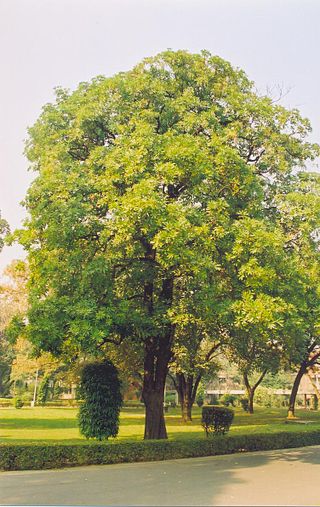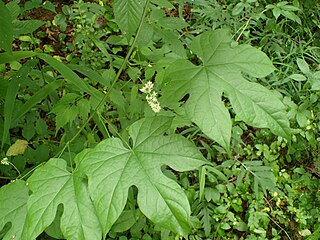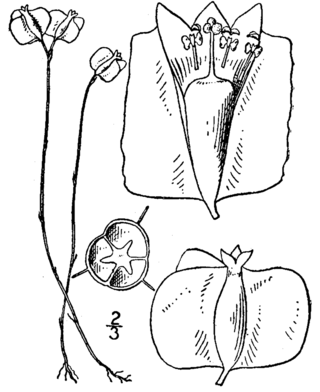
Helianthus is a genus comprising about 70 species of annual and perennial flowering plants in the daisy family Asteraceae commonly known as sunflowers. Except for three South American species, the species of Helianthus are native to North America and Central America. The best-known species is the common sunflower. This and other species, notably Jerusalem artichoke, are cultivated in temperate regions and some tropical regions, as food crops for humans, cattle, and poultry, and as ornamental plants. The species H. annuus typically grows during the summer and into early fall, with the peak growth season being mid-summer.

Alstonia is a widespread genus of evergreen trees and shrubs, of the family Apocynaceae. It was named by Robert Brown in 1811, after Charles Alston (1685–1760), professor of botany at Edinburgh from 1716 to 1760.

Eriocaulon is a genus of about 400 species commonly known as pipeworts, of monocotyledonous flowering plants in the family Eriocaulaceae.

Acer floridanum, commonly known as the Florida maple and occasionally as the southern sugar maple or hammock maple, is a tree that occurs in mesic and usually calcareous woodlands of the Atlantic and Gulf coastal plain in the United States, from southeastern Virginia in the north, south to central Florida, and west to Oklahoma and Texas and also common in south Illinois and Missouri

Eriocaulon decangulare, commonly known as ten-angled pipewort, hat pin and bog button, is a monocotyledonous plant native to the eastern United States, Mexico and Nicaragua. The plant's distribution is quite irregular, with several disjunct populations and a discontinuous primary range. Most of its habitat in the United States is found on the Atlantic Coastal Plain. It is found in areas of relatively low elevation and does not occur higher than 300 metres above sea level. This plant is found in peat and sand that is moist to wet, and is associated with savannahs, bogs, pinelands, ditches and the banks of cypress domes.

Quercus sinuatavar. breviloba, commonly called Bigelow oak or Bigelow's oak, is a variety of Quercus sinuata, a species of oak tree that grows in parts of the southern United States and northeastern Mexico. Common names for this taxon are shallow-lobed oak, white shin oak, scaly-bark oak, limestone Durand oak, and shortlobe oak. The less specific common name bastard oak may refer to either of the two varieties of Quercus sinuata, var. sinuata and var. breviloba. Other common names include scrub oak or shin oak, but these names may refer to a number of other low growing, clump forming oak species, subspecies or varieties. For clear differentiation in common reference, American Forests uses Durand Oak to mean Quercus sinuata var. sinuata and Bigelow oak to mean Quercus sinuata var. breviloba, a shrubby variety of Quercus sinuata distinguished in part by its habit of forming clonal colonies in parts of its range.

Eriocaulon parkeri is a species of flowering plant in the pipewort family known by the common names Parker's pipewort and estuary pipewort. It is native to eastern North America, where its distribution spans the coast from Quebec to North Carolina. It is extirpated from New York and Pennsylvania, however.

Eriocaulon scariosum, commonly named common, rough or pale pipewort, is a species of tufted grass-like herbaceous plants, constituting part of the plant family Eriocaulaceae. The scientific name of Eriocaulon is derived from Ancient Greek εριον, erion, which means 'wool', and καυλός, caulos, which means 'stalk'. Common pipewort plants grow naturally in wetlands, bogs and drainage areas, from central and eastern Victoria, through eastern New South Wales, including the Australian Capital Territory, to eastern and north Queensland, Australia.

Parietaria praetermissa, the clustered pellitory, is a plant species native to the coastal plains of the southeastern United States, i.e., Georgia, Florida, Louisiana, North Carolina and South Carolina. It grows in hammocks, waste places, calcareous outcrops, etc., at elevations of 10 m.
Melanthium woodii, common names Wood's bunchflower or Ozark bunch-flower, is a species formerly known as Veratrum woodii. It is native to the central and southeastern parts of the United States, from Arkansas, Florida, Georgia, Illinois, Indiana, Iowa, Kentucky, Missouri, North Carolina, Ohio, Oklahoma and Tennessee. It can be found in forested areas at elevations less than 800 m.

Styrax americanus, the American snowbell or mock-orange, is a plant species native to the southeastern United States and the Ohio Valley. It has been reported from Texas and Florida to Virginia and Missouri. It generally grows in swamps and on floodplains and in other wet locations.

Calycocarpum (cupseed) is a monotypic genus of flowering plants in the family Menispermaceae. The only species currently accepted is Calycocarpum lyonii endemic to the southeastern United States.

Burmannia capitata is a plant species widespread across the West Indies and much of Latin America. It grows in wet areas at elevations less than 100 m. It has been reported from Argentina, Belize, Bolivia, Brazil, Cuba, the Dominican Republic, Haiti, Jamaica, Puerto Rico, Trinidad & Tobago, Colombia, Costa Rica, French Guiana, Guyana, Honduras, southern Mexico, Nicaragua, Panamá, Paraguay, Suriname, Venezuela, and the United States

Parietaria floridana, common name Florida pellitory, is a plant species native to the southeastern United States, the West Indies, and much of Latin America. In the US, the heart of its range extends from Florida, to Georgia and North and South Carolina, with isolated populations reported in Mississippi, Louisiana, Texas, New Hampshire, Kentucky and Delaware. Some populations in California have in the past been referred to as P. floridana but are now regarded as a separate species, P. hespera.

Persicaria sagittata, common names American tearthumb, arrowleaf tearthumb, or arrowvine, is a plant species widespread in the eastern half of North America as well as in eastern Asia. It has been found in every state and province from Texas to Manitoba to Newfoundland to Florida, plus Colorado and Oregon. It also grows in China, the Russian Far East, Siberia, Korea, Japan, northern India and Mongolia. It grows in moist areas along lake shores, stream banks, etc.

Burmannia biflora, common name northern bluethread, is a plant species native to Cuba, the Bahamas and to the southeastern United States. It has been reported from Puerto Rico, eastern Texas, Louisiana, southwestern Arkansas, southern Mississippi, southern Alabama, Florida, Georgia, South Carolina, North Carolina and southeastern Virginia.

Iris hexagona, commonly known as the Dixie iris, is a species in the genus Iris, it is also in the subgenus Limniris and in the series hexagonae. It is a rhizomatous perennial with long bright green leaves, long thin stem and has small groups of flowers in shades of blue, from violet, to bluish purple, to lavender. It flowers in springtime and is native to the southeastern and south-central US states.

Iva angustifolia is a species of flowering plant in the family Asteraceae known by the common name narrowleaf marsh elder. It grows in the south-central and southeastern United States.

Eriocaulon australasicum is an endangered monocotyledonous plant in the Eriocaulaceae family found in Australia, in Victoria, South Australia and New South Wales.

Syngonanthus flavidulus, common name yellow hatpins, is a flowering plant. It grows in the southeastern United States including Alabama, Florida, Georgia, North Carolina and South Carolina. It is in the Syngonanthus genus and pipewort family Eriocaulaceae. A perennial, it grows to about a foot in height. It grows in flatwoods, prairies, and pond margins. It has very small flowers that bloom February to July and appear as small white buttons and it has shiny leaves. Eugen Otto Wilhelm Ruhland reclassified it from Eriocaulon to Syngonanthus in 1903.


















